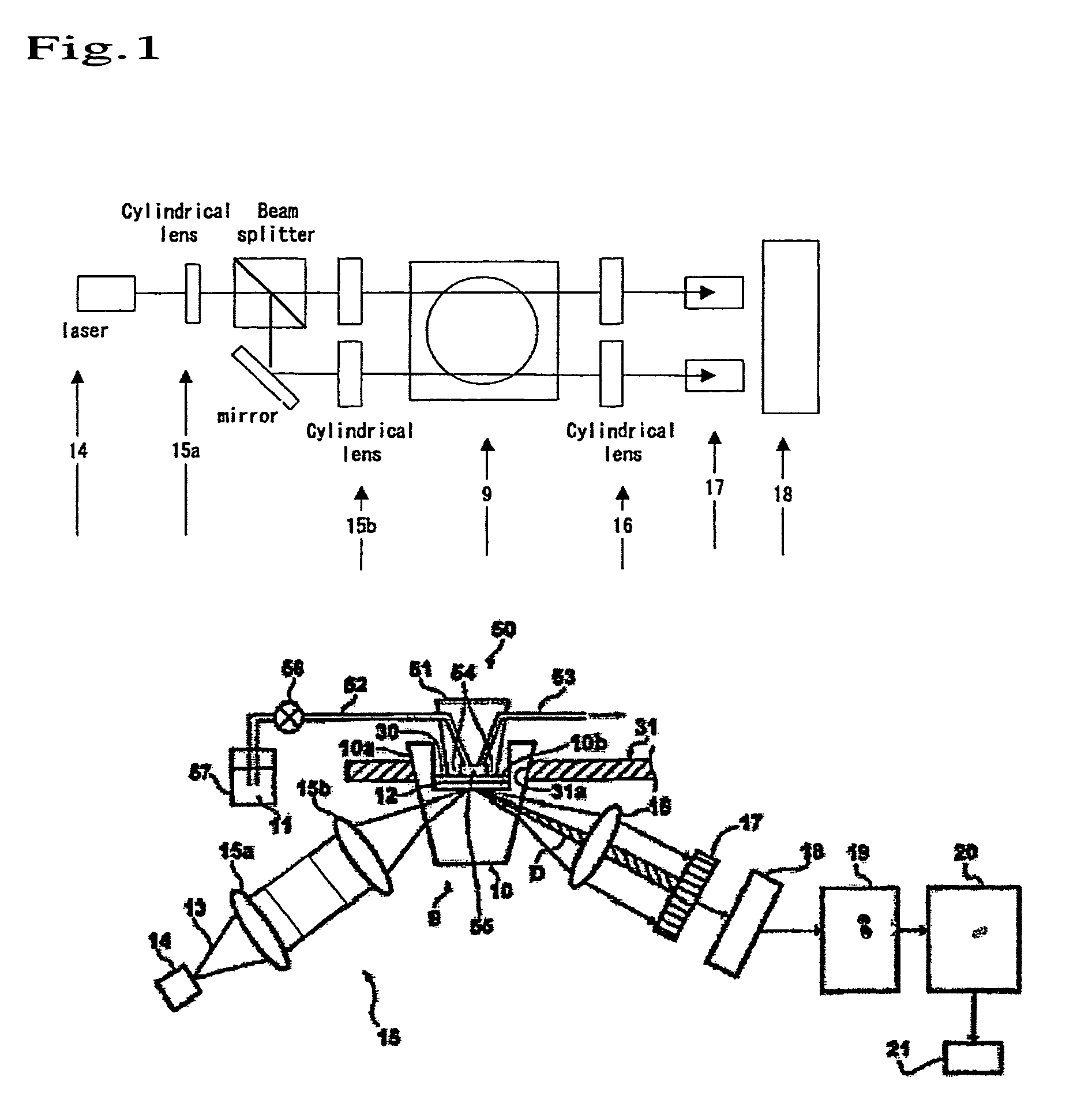Biosensor
a biosensor and sensor technology, applied in the field of biosensors, can solve the problems of high probability of nonspecific adsorption on the above detection surface, insufficient control of nonspecific adsorption by this method, and excessive amount of carboxylic acid on the surface, so as to suppress nonspecific adsorption, suppress nonspecific adsorption, and not significantly affected by baseline fluctuation
- Summary
- Abstract
- Description
- Claims
- Application Information
AI Technical Summary
Benefits of technology
Problems solved by technology
Method used
Image
Examples
examples
[0150]The device described in FIG. 1 (the surface plasmon resonance measurement device of the present invention) was used in experiments. The detailed descriptions of the device shown in FIG. 1 are found in Japanese Patent Application Laid-Open (Kokai) No. 2003-254906. Evaluation of a two-part split surface and measurement with two cups were carried out under the same conditions by adjusting the width of an optical path after a beam splitter.
example a
Example A-1:
Production of Measurement Chip (the Present Invention)
(1) Production of Polymethyl Methacrylate (PMMA) Film
[0151]A dielectric block onto which gold with a thickness of 50 nm had been evaporated as a metal film was treated with a Model-208 UV-ozone cleaning system (TECHNOVISION INC.) for 30 minutes. Thereafter, 5 μl of a methyl ethyl ketone solution containing 1 mg / ml polymethyl methacrylate was added thereto such that it came into contact with the metal film. It was left at rest at 25° C. for 15 minutes.
(2) Production of Measurement Chip by Treating Polymethyl Methacrylate Film with NaOH
[0152]1 N NaOH aqueous solution was added to the sample produced in (1) above, such that it came into contact with the PMMA film. It was left at rest at 60° C. for 5 hours. Thereafter, it was washed with water 3 times. This sample is called a PMMA / NaOH treated chip.
(3) Production of Two-Part Split Surface
[0153]100 μl of a mixed solution consisting of an ethanol solution containing 400 mM ...
example a-2
Production of Two-Part Split Surface by Contact
[0156]A stamp used to come into contact with a half portion of the measurement unit of an dielectric block used in measurement was produced from PDMS. The surface thereof was treated with plasma ozone, so as to ensure the wetting properties of the solution.
[0157]100 μl of a mixed solution consisting of an ethanol solution containing 400 mM 1-ethyl-2,3-dimethylaminopropylcarbodiimide and an ethanol solution containing 100 mM pentafluorophenol at a ratio of 1:1 was added to the sample produced in (2) in Example A-1. It was left at rest at 25° C. for 30 minutes. Thereafter, it was washed with ethanol 5 times. Thereafter, a stamp that had been immersed in an ethanol solution containing 10 mM biotin-LC-amine (manufactured by PIERCE) was allowed to come into contact with the sample for 20 minutes. Thereafter, the stamp was removed from the sample, and 40 μl of an ethanol solution containing 1 M ethanolamine was added thereto, and it was left ...
PUM
| Property | Measurement | Unit |
|---|---|---|
| thickness | aaaaa | aaaaa |
| thickness | aaaaa | aaaaa |
| temperature | aaaaa | aaaaa |
Abstract
Description
Claims
Application Information
 Login to View More
Login to View More - R&D
- Intellectual Property
- Life Sciences
- Materials
- Tech Scout
- Unparalleled Data Quality
- Higher Quality Content
- 60% Fewer Hallucinations
Browse by: Latest US Patents, China's latest patents, Technical Efficacy Thesaurus, Application Domain, Technology Topic, Popular Technical Reports.
© 2025 PatSnap. All rights reserved.Legal|Privacy policy|Modern Slavery Act Transparency Statement|Sitemap|About US| Contact US: help@patsnap.com



